Adventures at Sea
Deep Sea Fish and Sediment Surveys in the Gulf
Deep Sea Fish and Sediment Surveys in the Gulf

May 18th
On this research voyage I am getting to help with seawater filtration. Each time the rosette of Niskin bottles goes down to different depths, they collect 144 liters of seawater at different depths, The processing I am doing is used to measure CHN for the elements carbon, hydrogen, and nitrogen, the basic elements of life. I take 2-Liter bottles of seawater and filter the water to concentrate the carbon, hydrogen, and nitrogen on filters about the size of a quarter coin.
Other scientists are filtering seawater to collect particulate matter, chlorophyll a, and accessory pigments from phytoplankton for later analysis on shore using analytical tools like spectrophotometry and HPLC (High Pressure Liquid Chromatography). Some of the water is also tested for nutrients that are needed for phytoplankton to grow, somewhat like multivitamins.

The weather has been beautiful, sunny, and cool this morning but hot this afternoon. We have finished most of the deep water sites (depths to 2300 meters. Sediment cores are hardest to retrieve from the deepest sites. Equipment and weather can easily interfere with successful collection of core samples. This expedition is on track for achieving all of its science goals. This is unusual on a research voyage, weather might interfere and delay or stop collection of seawater, plankton, or sediment samples or equipment could malfunction. At one of the deepest sites, the sediment cores came back up with only water, but due to the good weather and several researchers needing data from the sediment samples the expedition was able to revisit that site to collect the sediment samples. Field science even in the sunny Gulf of Mexico doesn’t always work out that way, in fact it usually does not.
This is also some of the equipment that is deployed (used) last at each sampling station. The sediments, at least those that I have seen collected have soft sediment layers. Some of it is muddy, has a silky texture and is softly workable with your fingers— like potters clay. The cores we are collecting don’t show a lot of layers but there is some evidence of activity stirring up the sediments as the worms and microbes and other small creatures feed and burrow (rework) in the sediments often recycling nutrients.

May 18th
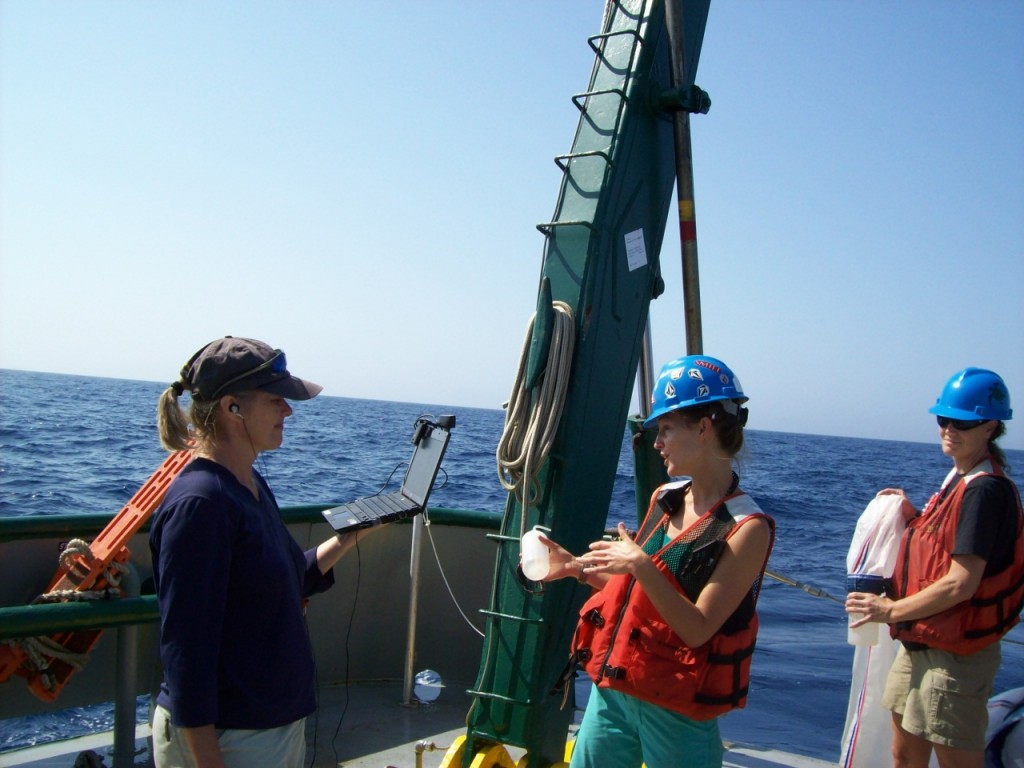
C-IMAGE Chief Scientist Leslie Schwierzke-Wade talking with 3rd graders at Jamerson Elementary in Florida during a Skype ship to shore video-conference (also pictured, Scientists Heather Broadbent and Teresa Greely)
We have had many visitors from shore join us at sea via Skype video events. Thank you to all the students, teachers and scientists for your participation this week. It has been exciting and important to share with everyone on shore about our research this cruise, which focuses on the lower end of the food web in the northern Gulf of Mexico’s water column. Our first students aboard were from Mr. Holby’s class at Lake Region High School in Polk County. We hope your chemistry students enjoyed the experience during their C-IMAGE voyage. Thank you for sharing this summary, “They all got a kick out of us trying to Skype; I think just the fact we were using it and speaking to someone, so far away really hit home that it is a useful tool for “real” work and not just socializing! “

Science Technician, Andrew Warren sharing with students during a Skype visit how the on-board CTD (conductivity-temperature-depth) instrument package works
We send a shout out to students in Pinellas County, Florida at Guardian Angels Catholic School and Clearwater Intermediate School. A wave of thanks goes to Mrs. Deeley and Mr. Reese for helping to coordinate the Skype events for their students. Mrs. Deeley shared that her students, “…enjoyed seeing the sediment core sampling, plankton nets, the filtering station for Carbon-Hydrogen-Nitrogen, and learning about what the water column is showing us about marine life.” Mr. Reese’s Oceanography Club liked seeing the types of instrumentation and technology aboard the vessel. Sixth graders from Mrs. Watson’s class at Sarasota School of Arts & Sciences joined us just in time to see the sediment cores being retrieved from the ocean floor. She appreciated the opportunity for her students to see scientists in action.
Our final visit this week was from all the 3rd graders at Jamerson Elementary School. Ninety students came aboard in time to see the bongo nets retrieved and the plankton collected. Students toured the vessel, met the chief scientist Leslie Schwierzke-Wade, chemist Nikolaus Finke, then visited Andrew Warren the science technician on board, then to the bridge with to talk with Captain Brendon ‘Boomer’ Baumeister. So far this week, about 370 students have virtually sailed with us over the past four days.

Weatherbird II Captain Brendon "Boomer" Baumeister on the Bridge explaining to students during a Skype event about how the research vessel is operated and about how he became a captain.

May 17th

George Guthro, Brian Wells, and Teresa Greely pausing while sediment cores are traveling to the seafloor
Post by C-IMAGE Teacher, Mary St. Denis
This is my interpretation of Brian’s response to several questions asked by students in Robert Holby’s Lake Region High School chemistry class - Mary St. Denis
What made you interested in what you do and have you always wanted to do this for a living?
I grew up in Florida and always spent most of my time on or around the water. I wanted to become a marine biologist as many children do. I went to college and ended up going into Environmental Science instead of Marine Biology because the labs fit into my schedule better.
Since I was working my way through school, eventually a business took off and I had several businesses including a screen printing shop, tattoo parlor, and a motorcycle shop.
I am collecting marine sediment samples on board. I look at the biogeochemistry of the sediments along a depth and sediment gradient. The Deepwater Horizon blowout may have had immediate detrimental impacts on the ocean life but at this point there is not enough information to predict future consequences. We have evidence of a lot of microbial activity that is degrading the oil in the sediments. Some ecological communities on the sea floor may have been wiped out after the oil event but it was an opportunity for other species that can digest hydrocarbons to thrive.
A new food source (oil) means a new part of the food web develops while other parts may disappear. Now a number of scientists are trying to figure out what shifts in communities of organisms there have been since 2010.

May 16th
Post by CIMAGE Teacher- Mary St. Denis
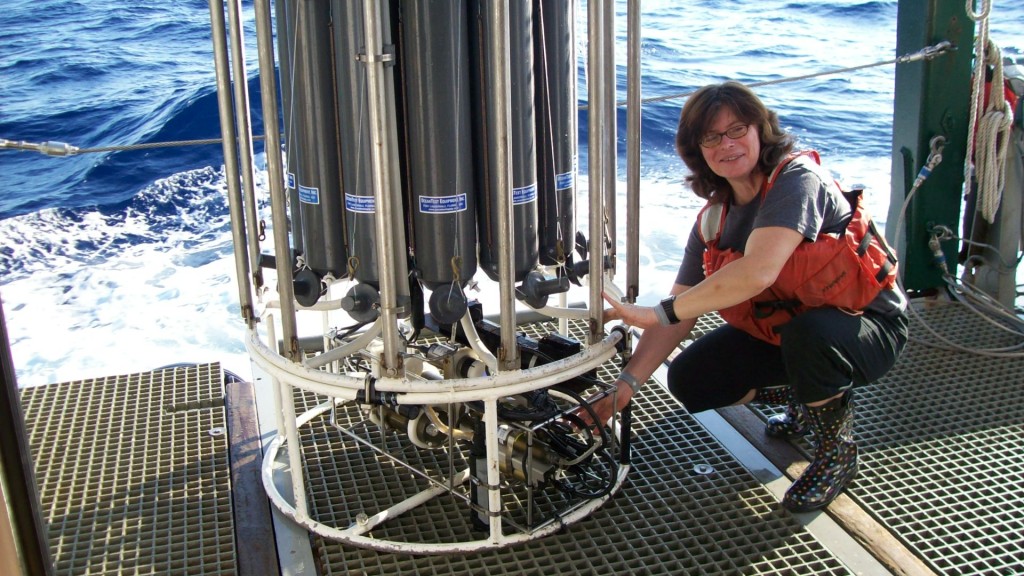
C-IMAGE Teacher, Mary St. Denis at Rosette of Niskin Bottles prepaing for a test run of the CTD system
My name is Mary St. Denis and I am happy to be the next C-IMAGE Gulf of Mexico Teacher @ Sea. I strongly feel that we as a society need to learn to respect and treasure water as the invaluable resource that it is, as well as a thing of beauty. This experience is very exciting for me in a variety of ways because I have always loved the water. As a very small child I would walk out into the water until it was over my head any time my mother looked away at the beach. I still spend as much time as I can around water; I kayak, scuba dive, and swim laps, in fact, last year I swam 88 miles overall.
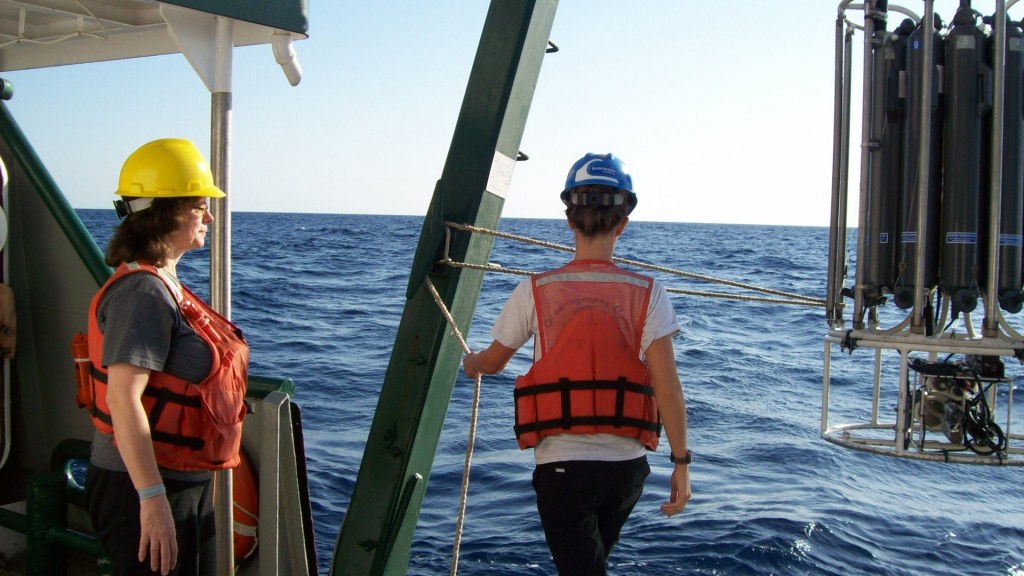
CIMAGE scientist, Leslie Schweirzke-Wade and teacher at sea Mary St. Denis retrieving rosette of Niskin bottles. The Niskin bottles collect water samples at discrete depths from the surface of the ocean to the seafloor
Both my students and I are very concerned about the effects of the Gulf Oil Spill on wildlife and the environment so I am really happy to be a part of finding out more about what is happening in the Gulf in the aftermath of the oil spill. I have taught science at Winter Haven High School for 8 years, and have a Master’s degree in Science Education and Bachelor’s in Biology: Microbiology. I currently teach Chemistry and AP Environmental Science and will be teaching Agricultural Biotechnology next year with WHHS’s Agribusiness Academy.
Prior to teaching I worked in a variety of science positions but had gradually found that I was doing more paperwork and little of the hands on work that I love. I decided to go into teaching to do two of my favorite things, working with people and working in the lab.

May 15th
It is a beautiful morning and the crew and science team have loaded everything on board and we are motoring out to site of the former Deepwater Horizon drilling rig. It is a beautiful sunny day and the ship is moving along and I for one am trying to find my sea legs. You are much closer to the water than on a cruise ship, so close in fact that as we cross the deck in our closed toe shoes (safety first) our feet get wet. The seas are running 4 to 6 feet and waves regularly splash over the side. I am typing this sitting in the shade of one of the watch stations in a plastic stacking chair. Life is GOOD!
Teresa Greely and I are doing a variety of test calls for our video conferences on SKype but we have available times if any classrooms are interested in talking directly to us. You can e-mail mary.stdenis@polk-fl.net or greely@usf.edu if you are interested in setting up a videoconference. Besides blogging, I am also taking pictures and getting to know some of the crew and researchers. Today we are traveling to the first of the locations, near the Deepwater Horizon platform where we will do our monitoring of the ocean water, plankton, sediments, and methane in the water column.

May 11th
Post by CIMAGE Teacher- Mary St. Denis
It’s Saturday May 11th 2013, C-IMAGE scientists and educators are getting ready to head out to sea early Tuesday morning. We will be heading to the northern Gulf of Mexico to monitor the health and recovery of the plankton community as well as the general marine ecosystem and collect sediment samples between the site of the 2010 Deepwater Horizon blowout and several locations offshore of the Alabama and Florida coast. Take a virtual tour of the research vessel
Waiting to head out to sea
For researchers an expedition may be exciting or just another day at the office, but for me as the teacher accompanying the expedition it is an exciting countdown to an adventure. Many people don’t realize that science teachers are scientists too, sometimes even the teachers do not realize it. We do not get many chances to get out in the field and do science and that is a dream spot for many, many teachers like myself.
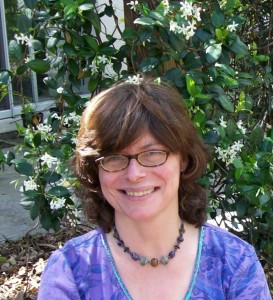
C-IMAGE Teacher at Sea: Mary St. Denis from Winter Haven High School in Polk County, FL. This is her first science expedition at sea.
Our mission
… to continue assessing the impact of BP Oil on Florida’s continental shelf ecosystems by comparing areas not impacted by oil (west Florida shelf) to areas impacted by oil (north Florida shelf)
We will be investigating the impacts of the blowout by focusing on the base of the food web, plankton and the bottom of the sea floor by collecting samples of the sediments at a variety of depths. Researchers from the College of Marine Science (USF) and RSMAS/University of Miami will assess the impact of oil on Florida marine ecosystems by comparing non-impacted west Florida shelf and impacted north Florida shelf sites.
Join us during the cruise
Please check in regularly to learn about the science that is happening aboard this research cruise. Mary St. Denis would also love to Skype with classrooms to help bring these exciting adventures directly to you!
If your classroom or group would like to participate in a LIVE video conference via Skype during our expedition, please contact Teresa Greely at greely@usf.edu for details.
Mar 27th
C-IMAGE teacher Susan Cullum
Due to rough seas, Captain Dave Coy and C-IMAGE Chief Scientist Leslie Schwierzke-Wade had to make the very difficult decision to postpone the March cruise. However, the good news is that we have been rescheduled for April 15th-21st!
Please check back in a few weeks for the upcoming cruise!
Please email me at scullum@pasco.k12.fl.us if you are interested in a direct ship to classroom Skype session.
See you in a few weeks!

Mar 22nd
C-IMAGE Teacher Susan Cullum
The March 2013 C-IMAGE research cruise is about to begin. Rough seas have delayed our original departure date of Friday, March 22nd. However, the Florida Institute Oceanography (FIO) operators project a possible go ahead for a late afternoon departure on Monday, March 25th. As anxious as we all are to head out to sea, we need to always put our safety and the security of the ship and the equipment first.
Geographic Area. We will collect measurements at stations along two transects on the west Florida shelf (see above). One transect extends out from Tampa Bay (~10 m to 860 m on the shelf/slope) and the other transect extends from the Big Bend area out to the shelf/slope. There will be five primary interdisciplinary CTD stations on each transect at ST 03, 06, 12, 18, 24, and NT 07, 13, 19, 25, and 31.
Expedition Description:
Under the leadership of C-IMAGE Scientist, Dr. Kendra Daly (http://www.marine.usf.edu/zooplankton/) C-IMAGE continues its offshore surveys of the Gulf of Mexico. Researchers from the College of Marine Science/USF and RSMAS/University of Miami will assess the impact of oil on Florida marine ecosystems by comparing non-impacted west Florida shelf and impacted north Florida shelf sites. This cruise will focus on coupling in situ and shipboard analyses of physical and chemical parameters, with biological studies of toxicity, microplankton community health, and the abundance and distribution of plankton. Our Science Party includes Chief Scientist, Leslie Schwierzke-Wade (USF), Karen Dreger (USF), Jonelle Basso (USF), Sharien El-Tourkey (UM), Matt Flynn (Eckerd College), Tess Rivenbark (USFSP Honors), Teri Deardorff (USFSP Honors).
Specific research objectives include:
Meet Susan Cullum, our C-IMAGE Teacher at Sea
Susan Cullum teaches at Wesley Chapel High School (WCHS) in Pasco County, FL. This is her 9th year teaching at WCHS where she currently teaches Marine Science Honors, Biology, and Dual Enrollment courses in Oceanography and Environmental Science. Susan is not new to science research, she holds an M.S. in Marine Biology from U of Maine and a B.S. in Marine Science from U South Carolina. She looks forward to the research cruise to expand her hands-on experience doing scientific research, the opportunity to take these experiences back into her classroom and integrate them into her instruction.
Please check in regularly to learn about the science that is happening aboard this research cruise! Susan Cullum would also love to Skype with classrooms to help bring these exciting adventures directly to you!
If your classroom or group would like to participate in a LIVE video conference via Skype during our expedition, please contact Susan Cullum, scullum@pasco.k12.fl.us for details.

Feb 19th
As the C-IMAGE February 2013 cruise comes to an end, here are some closing thoughts from our Chief Scientist, Leslie Schwierzke-Wade.
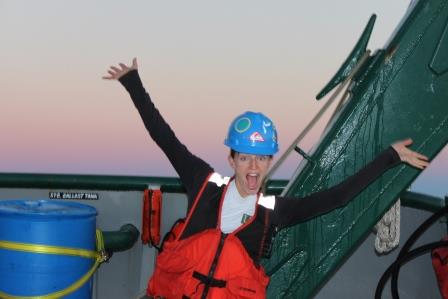
C-IMAGE Cruise Chief Scientist, Leslie Schwierzke-Wade on deck of WBII after the successful recovery of multiple samples during C-IMAGE Feb 2013 cruise
It is an absolute blast operating as Chief Scientist on Dr. Kendra Daly’s research cruises, especially when given the pleasure of working with an amazing team of scientists and crew. We had an incredibly diverse science party on board, including geological, biological, and chemical oceanographers, as well as two teachers at sea. This particular cruise, my 9th Deepwater Horizon oil response cruise, presented many challenges with equipment failures and rough seas, which ultimately shortened our expedition. However, thanks to the hard work of everyone on board, we managed to accomplish several of our science objectives, sampled majority of our targeted stations along the Panama City transect over the DeSoto Canyon, and collected many useful samples and data.

C-IMAGE Leslie Schwierzke-Wade and Matt Flynn (Eckerd College) deploying Bongo nets to collect plankton for biomass and identification samples
These research efforts will enable us to continue our assessment of the impacts of the oil spill on the northern Gulf of Mexico ecosystem, which focuses mostly on the lower end of the ocean food web (microbes, phytoplankton, and zooplankton). We will compare this data to those collected on previous cruises to evaluate temporal (over time) and seasonal changes in the water column and plankton populations.
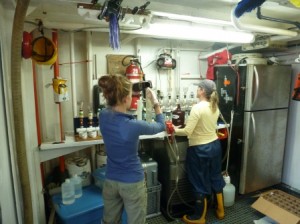
C-IMAGE Leslie Schwierzke-Wade and Teresa Greely filtering seawater samples for chlorophyll and HPLC analysis aboard WBII Feb 2013 cruise
Thank you to Matt MacGregor and Teresa Greely for their outstanding job of sharing our story with those on shore.

Feb 12th
Fellow Adventure-ers at Sea and C-IMAGE readers, it is that time of the research expedition when the sampling gear has been secured on deck, the lab equipment is being packed in dry boxes, and the science team is packing luggage. Yepper this C-IMAGE February 2013 expedition has come to a close as we are sailing pack to port in St. Petersburg, Florida. Matt MacGregor, our C-IMAGE Teacher at Sea from Escambia High School and I (Teresa Greely) would like to thank the science team for teaching us the science of the sea and training us to work as part of the science team. We also wish to thank the crew of the WBII for their help with the onboard comforts and assistance with internet access so we could Skype and blog during the expedition (especially, Andrew Warren). Thanks for the countless memories, sea stories and science research and lessons learned throughout the expedition. Thank you C-IMAGE Scientists, Leslie Schwierzke-Wade and Kendra Daly for welcoming us aboard as part of the science team.
Plan to join us for our upcoming C-IMAGE Teacher at Sea expeditions currently scheduled for March 22-18 aboard the R/V Bellows and May 14-23 aboard the R/V Weatherbird II.
If your classroom or group would like to participate in a LIVE video conference via Skype during our expeditions, please contact Teresa Greely, greely@usf.edu for details.
Enjoy these final photos that capture the lighter side of our time at sea.